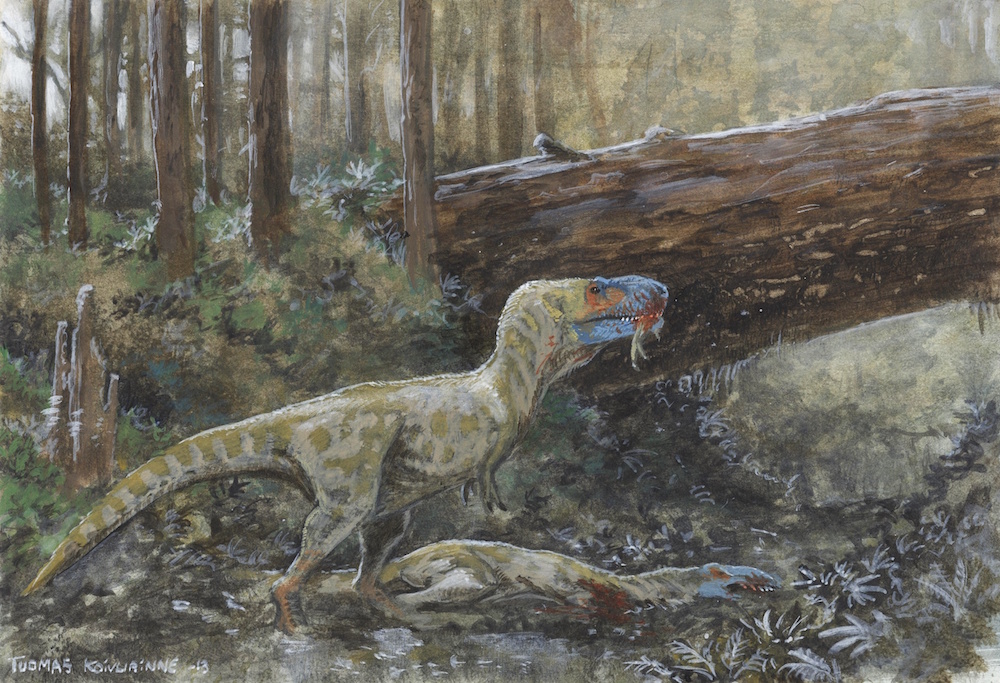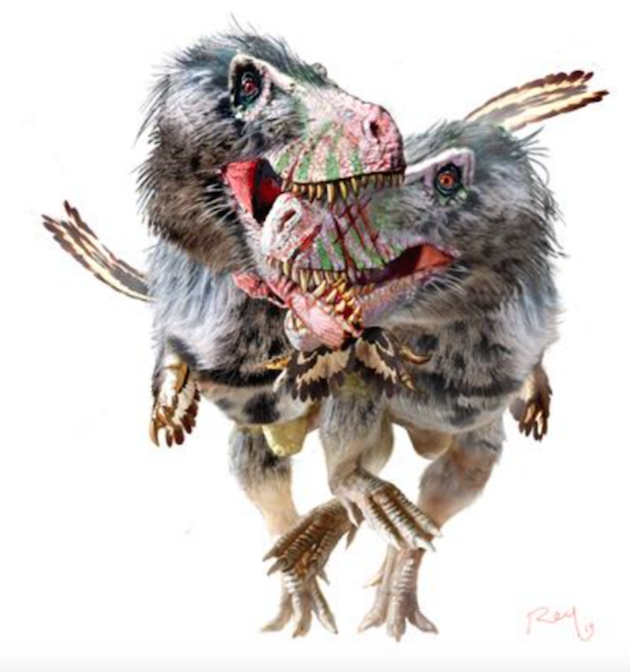Tyrannosaur Skull Bears Scars of Fierce Dino Battle

Some 75 million years ago, a towering tyrannosaur may have lit into one of its own species, ripping into its skull and leaving behind jagged scars and deep punctures that have only recently seen the light of day.
The beastly tale comes from paleontologists examining the marred skull of the possible dinosaur victim, which itself was a teenage tyrannosaur. Even so, scientists not involved in this study warrant caution in such interpretations, noting the difficulty of pinning ancient crimes on any one genus without more evidence.
Researchers originally discovered the dinosaur skull in 1994 in Dinosaur Provincial Park in Alberta, Canada. An analysis showed the bones belonged to Daspletosaurus, a genus of tyrannosaur — a group of carnivorous, bipedal dinosaurs with deep jaws and short arms that includes the notorious Tyrannosaurus rex. [See Amazing Illustrations and Photos of the Daspletosaurus]
Although paleontologists examined the Daspletosaurus after its excavation, the researchers of the new study are the first to do an in-depth analysis of its skull marks, said the study's lead researcher, Dave Hone, a lecturer in zoology at Queen Mary University of London.
The roughly 22-inch-long (55 centimeters) Daspletosaurus skull wasn't fully grown, and likely belonged to a subadult (the equivalent of an older teenager in human terms), he said. When it died during the Late Cretaceous, its entire body measured just less than 20 feet (6 meters) long and weighed about 1,100 lbs. (500 kilograms), he added.
Bone injuries
The researchers found a number of healed skull injuries. Several, including a circular puncture on the back of the skull, are similar in size and shape to tyrannosaur teeth, they said.
Get the world’s most fascinating discoveries delivered straight to your inbox.
"There are a few on the skull which are pretty definitely bites from another big carnivore, and because we're dealing with Daspletosaurus, that pretty much means it has to be a tyrannosaur," Hone told Live Science.
He and his colleagues suggest that another Daspletosaurus injured the specimen, largely because the genus was the only other large carnivore around in that period besides crocodilians, prehistoric relatives of crocodiles. But crocodilians found in the same rock formation as the dinosaur tend to be small, with a skull length of about 20 inches (50 cm), "and [was] thus unlikely to have left such large marks," the researchers wrote in the study.
It's also thought that crocodilians tended to bite and twist, and there isn't evidence of that on the Daspletosaurus skull, Hone said.
Hone isn't surprised that a Daspletosaurus might have fought with its own kind.
"Animals that tend to get into big face-to-face fights tend to be members of your same species," he said. [Image Gallery: Boneheaded Dinosaurs Butt Heads]
The researchers also found postmortem damage to the right jaw. The marks are likely from a scavenger. Another tyrannosaur — possibly from the same species — may have left the marks, which would suggest cannibalism, the researchers said.
An examination showed four parallel score marks on the right jaw, which is broken closer to the face.
"So, probably, something bit into that, scrapped down through it and snapped or busted through the rest of the back of the jaw," Hone said. "That's the only postmortem one we got, or that we're confident about, but it's a pretty devastating one."
Another perspective
Other experts say the study makes a strong case for such aggressive behavior but it's impossible to know what creatures may have injured the Daspletosaurus.
"We didn't see anything happen," said Thomas Carr, an associate professor of biology at Carthage College in Wisconsin and a vertebrate paleontologist who studies tyrannosaurs. "All we have are bones on a table with lesions. We have to be very careful as scientists in attributing cause," said Carr, who was not involved in the new study.
Mark Norell, a vertebrate paleontologist at the American Museum of Natural History in New York who was not involved in the study, seconded the call for caution.
"From the bite marks alone, I think it's kind of tough" to tell what bit the Daspletosaurus, Norell told Live Science.
There are ways to learn what may have caused the injuries — for instance, if the culprit left behind a tooth (many dinosaurs would shed teeth when they ate) or an imprint of a serration of a tooth, he said. But without these clues, it's difficult to know what bit the Daspletosaurus, Norell said.
It would be interesting to examine 20 to 30 tyrannosaur skulls, and look for wounds that spanned the collection, Carr said.
For instance, if a number of skulls have lesions around their mouths, it might be reasonable to infer that the dinosaurs had bitten into bone and that the bone had splintered and injured them, Carr said. The same goes for cannibalism — multiple specimens with unambiguous evidence are needed to determine if it was widespread, he said.
Hone said he and his colleagues tried to be conservative in their interpretation of the fossil marks. "I'm definitely aware of the problems of overinterpretation with things like this," he said, adding that the evidence points toward tyrannosaursas credible assailants for some of the injuries.
In fact, Hone said he already has plans to measure every tyrannosaur skull he can get his hands on, to look for patterns, but such an undertaking takes time.
The study was published today (April 9) in the journal PeerJ.
Follow Laura Geggel on Twitter @LauraGeggel. Follow Live Science @livescience, Facebook & Google+. Original article on Live Science.

Laura is the managing editor at Live Science. She also runs the archaeology section and the Life's Little Mysteries series. Her work has appeared in The New York Times, Scholastic, Popular Science and Spectrum, a site on autism research. She has won multiple awards from the Society of Professional Journalists and the Washington Newspaper Publishers Association for her reporting at a weekly newspaper near Seattle. Laura holds a bachelor's degree in English literature and psychology from Washington University in St. Louis and a master's degree in science writing from NYU.




